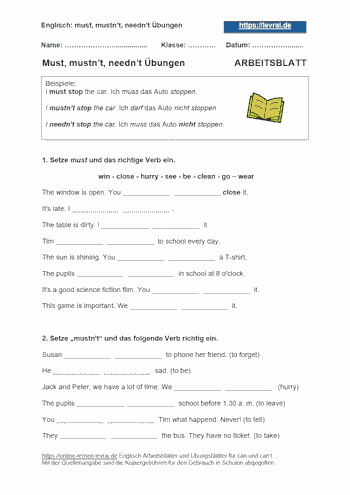1 „Must, mustn't, needn't“
Schnell gelernt: „Must, mustn't, needn't“
must: → = „müssen“: Notwendigkeit oder Zwang.
mustn't: → = „nicht dürfen“: Ausdruck für ein Verbot.
needn't: → = „nicht müssen“: Etwas ist nicht notwendig.
„Must“ drückt immer eine Notwendigkeit aus. Der Ausdruck „needn't“ bedeutet, dass etwas nicht notwendig ist. Wichtig ist: Die Verneinung von „must“ mit „mustn't“ meint „nicht dürfen“! „Mustn't“ drückt ein Verbot aus.
Das Hilfsverb „must“
„Must“ drückt aus, dass man etwas machen
muss.
„Mustn't“ bedeutet, dass man etwas nicht darf
(Verbot).
„Must“ ist ein englisches Modalhilfsverb. Das Hilfsverb „must“ wird immer zusammen mit einem Vollverb im Infinitiv verwendet. Es drückt eine Verpflichtung oder eine starke Vermutung aus.
Nach „must“ folgt der Infinitiv
„Must“ bleibt genauso wie „can“ in allen Personen gleich. Nach „must“ folgt die Grundform (Infinitiv) eines anderen Verbs.
Beispiele für „must“: |
Beispiele: für „mustn't“ |
Vom Hilfsverb „must“ gibt es keine Verlaufsform (progressive).
Wann benutzt man „needn't“
Um zu sagen, dass man etwas nicht machen muss, dafür benutzt man „needn't“. Danach folgt die Grundform (Infinitiv) eines anderen Verbs.
Beispiele für die Anwendung von „needn't“
Ich brauche das Auto nicht anzuhalten ...
I needn't stop
the car.
You needn't
stop the car
He / She / It needn't
stop the car.
We needn't stop
the car.
You needn't
stop the car.
They needn't
stop the car.
„Must, mustn't, needn't“ Übungen
1 must man darf etwas nicht machen
2 must Übungen
3 must Übungen
4 Sätze mit must Sätze mit must bilden
5 must Übungen
6 Sätze mit must Sätze mit must bilden
7 must Übungen
8 mustn't Sätze mit mustn't.
9 needn't Sätze mit needn't bilden.
10 Must, mustn't, needn't must, mustn't, needn't
11 must, mustn't, needn't must, mustn't, needn't
12 must, mustn't, needn't must, mustn't, needn't
13 must, mustn't, needn't must, mustn't, needn't
Ergänzende Übungen
mustn't/needn't - Übungen (Klasse 6)
Arbeitsblätter für „must, mustn't , needn't“.
Englisch Arbeitsblätter
Scan mich! QR-Code für must, mustn't und needn't - Übungen: |
 |
Needn't, must und mustn't - exercises
Englisch-Übungen für „must, mustn't, needn't“ mit Regeln, Beispielen und Lösungen, auch als PDF exercises. Englisch-Arbeitsblätter mit Beispielen zum Online-Lernen für „must, mustn't, needn't“ - Übungen in Klasse 5, Klasse 6, Klasse 7, Klasse 8 und Klasse 9.
nächste Übung

